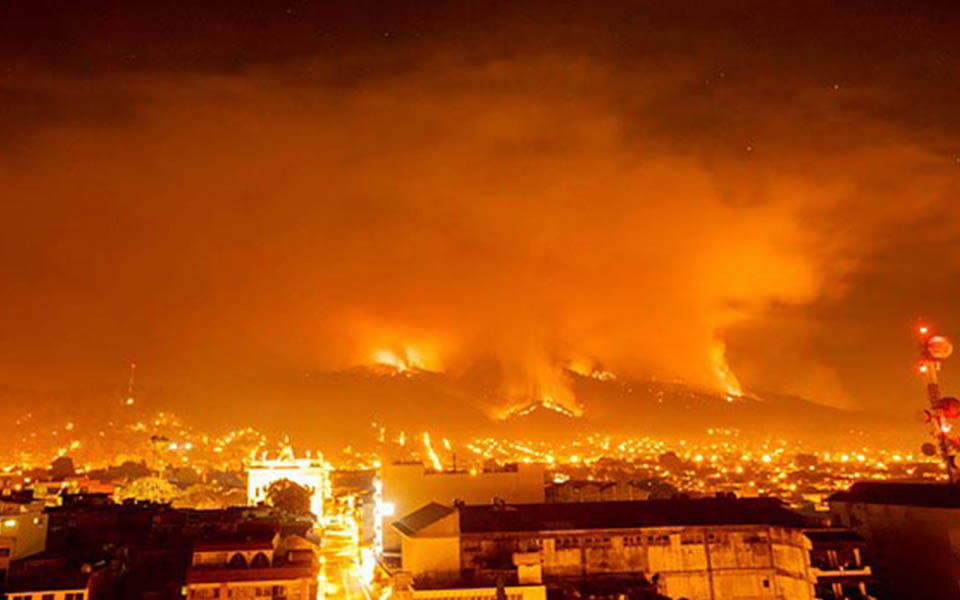Every year over 100,000 wildfires ravage 4 to 5 million acres, costing the U.S. government up to $2 billion in suppression costs. Longer wildfire seasons, brought on by scorching heat and changing weather patterns make these events more dangerous and harder to control.
While these natural disasters may seem exclusive to the western U.S., every state faces wildfire risks. A tragic reminder came with Maui’s devastating wildfire that destroyed 2,200 structures and caused $5 billion in damages and over 100 deaths. Even regions like the Mid-Atlantic are on alert with a warning from the U.S. Forest Service of heightened fire risk conditions through 2024.
Amid this sobering reality, proactive measures are paramount to shield your business from wildfires. While no property is fireproof, review the following strategies to fortify your property and operations.
Impacts of Wildfires on Businesses
Wildfires can have severe repercussions for businesses. The destruction extends beyond physical property damage, potentially requiring operational halts for emergency evacuations. Employees might be forced to evacuate, impacting their ability to work and recover personally. Transportation routes can be blocked, disrupting supply chains, and utility infrastructure can take extended periods to restore, further delaying business operations. These disruptions can lead to significant financial losses, both in immediate expenses and long-term revenue impacts.
Looking for protection tips from other weather events? Download our Severe Weather Preparedness Guide for help with hurricanes, flooding, tornadoes and much more!
Legal & Financial Consequences of Wildfires
The financial impacts of wildfires include the cost of the initial damage, recovery expenses and potential depreciation of property value due to substandard repairs. Insurance claims may lead to increased premiums or policy cancellations. Moreover, falling victim to contractor fraud, common after natural disasters, can compound these losses through legal fees, litigation costs and penalties from regulatory violations. Ensuring thorough due diligence when hiring contractors is essential to avoid further financial and legal complications.
Wildfire Preparedness Risk Management Strategies
Landscaping
It is an unfortunate fact that a high percentage of businesses ignite after the strongest part of the wildfire has passed due to smoldering leaves, grass or brush. Ask your property management company about steps they have taken to protect the building from wildfire damage in their landscaping selections. Some things that can help include using non-highly flammable plants and trees, pruning, and keeping the ground clear and the grass short. Consider creating a natural fire break for your property. This is usually a 10-foot-wide gap in vegetation or other combustible material that acts as a barrier to slow or stop the fire’s progress.
Building Materials
There are many updates and small renovations you can make to your property to help combat the fire. The absolute key, however, is to understand the unique ways a fire could attack your property. This helps determine which sides of the business should be fire-proofed first.
The following are business renovation ideas to help reduce the risk of wildfire damage:
- Windows: A vulnerable point in your property’s structure, windows are susceptible to breaking or shattering under the influence of heat, regardless if flames are close to your property. A safe alternative to the standard pane window is double-glazing your windows with tempered glass on the exterior. Roll-down metal fire doors that can be built into the roof overhangs are also strong defenders against heat and fire.
- Doors: The standard wood door typically provides 20 minutes of fire protection. For extra safety and more time, consider replacing your wood door with one with a metal core. If your business has garage doors, metal-panel garage doors can help reduce the risk of wildfire damage.
- Roofs: According to the Federal Emergency Management Agency (FEMA), roof materials should be compiled of noncombustible coverings that are Class A rating, such as metal or asphalt. Additionally, be sure to regularly have gutters and downspouts cleaned; this will decrease fuel for the fires.
- Vents: Ensure that your bathrooms, kitchens and dryer vents have automatic backdraft dampers and fire-rated assemblies. Metal sleeves and hoods need to cover all plastic plumbing vents where they penetrate your roof.
Fire Protection Systems
Having proper systems in place to detect and combat fire is also crucial. Ensure they are installed correctly, and regularly maintained and tested as recommended or required by relevant regulatory agencies such as the National Fire Protection Association (NFPA) and the Occupational Safety and Health Administration (OSHA).
Here are some of the systems you should have in place to alert workers of fire danger and help stop the spread:
- Fire alarms: At a minimum, you should have a properly designed, approved and installed fire alarm system to alert occupants. Today’s systems may also notify the fire service or building maintenance, control other fire safety devices and even provide data to fire respondents.
- Fire extinguishers: These essential tools play a critical role in ensuring workplace safety. Be sure to follow compliance standards to ensure your company and employees are protected.
- Sprinklers: For early fire control and extinguishment, your building needs properly designed, approved, installed and maintained sprinklers. Sprinklers help to mitigate the fire hazard to both occupants and firefighters.
- Emergency power: Depending on your building and fire codes, you may need to have a backup power system. Emergency power system features include illuminated exit signs, emergency lighting, fire alarm and detection systems, occupant-egress elevators, and electric fire pumps.
Financial Preparedness
Disasters can occur without warning, so it’s essential to prepare. Don’t wait to assess and revise your business’ disaster and continuity plans. Additionally, it would be beneficial to carefully review your insurance policy and make necessary updates to ensure adequate coverage.
Help mitigate risks by making digital copies of your property’s inventory. Don’t forget to save the receipts for major purchases or updates to your real estate. Ensure important documents, such as mortgage and insurance information, are stored electronically as well as in a fire-safe lock box. Take the time to video or photograph each room, including the closets and possibly inside drawers. Having a complete and accurate inventory will make recovery easier.
Establish a Comprehensive Wildfire Preparedness Plan
OSHA requires that any business with more than ten employees has a written Emergency Action Plan. It should include an evacuation plan for your employees and visitors with a designated meeting place. Make sure the evacuation route is easily accessible; outlines where to go, how to get there and what to take; and how to communicate with each other.
As always, monitor the conditions where your property is located and prepare employees if there is a high risk of wildfires reaching your business. Close all windows, doors and blinds, and leave the lights on in the building to aid firefighters. If your business is in an evacuation area and you are advised to leave, act immediately.
We’re Here to Help with Your Wildfire Preparedness
While wildfires are uncontrollable, there are steps you can take to protect your business and employees. Your property is a valuable asset, so it’s crucial to have safeguards in place. Prepare for the worst-case scenario by ensuring you have the right insurance coverage for disasters like wildfires. Connect with a member of our team to help with this process and be ready for any disaster.
© Copyright CBIZ, Inc. All rights reserved. Use of the material contained herein without the express written consent of the firms is prohibited by law. This publication is distributed with the understanding that CBIZ is not rendering legal, accounting or other professional advice. The reader is advised to contact a tax professional prior to taking any action based upon this information. CBIZ assumes no liability whatsoever in connection with the use of this information and assumes no obligation to inform the reader of any changes in tax laws or other factors that could affect the information contained herein. Material contained in this publication is informational and promotional in nature and not intended to be specific financial, tax or consulting advice. Readers are advised to seek professional consultation regarding circumstances affecting their organization.
“CBIZ” is the brand name under which CBIZ CPAs P.C. and CBIZ, Inc. and its subsidiaries, including CBIZ Advisors, LLC, provide professional services. CBIZ CPAs P.C. and CBIZ, Inc. (and its subsidiaries) practice as an alternative practice structure in accordance with the AICPA Code of Professional Conduct and applicable law, regulations, and professional standards. CBIZ CPAs P.C. is a licensed independent CPA firm that provides attest services to its clients. CBIZ, Inc. and its subsidiary entities provide tax, advisory, and consulting services to their clients. CBIZ, Inc. and its subsidiary entities are not licensed CPA firms and, therefore, cannot provide attest services.















